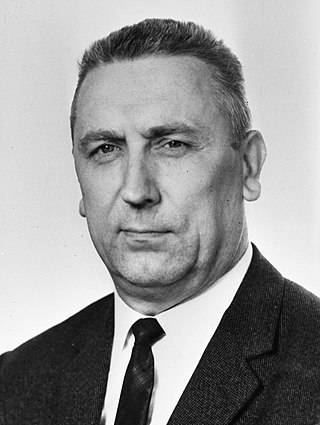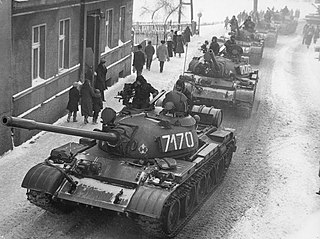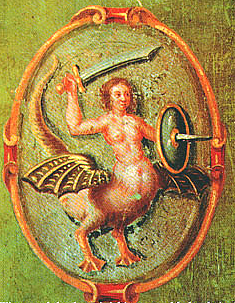
Warsaw, officially the Capital City of Warsaw, is the capital and largest city of Poland. The metropolis stands on the River Vistula in east-central Poland. Its population is officially estimated at 1.86 million residents within a greater metropolitan area of 3.27 million residents, which makes Warsaw the 7th most-populous city in the European Union. The city area measures 517 km2 (200 sq mi) and comprises 18 districts, while the metropolitan area covers 6,100 km2 (2,355 sq mi). Warsaw is an alpha global city, a major cultural, political and economic hub, and the country's seat of government. It is also capital of the Masovian Voivodeship.

Edward Gierek was a Polish Communist politician and de facto leader of Poland between 1970 and 1980. Gierek replaced Władysław Gomułka as First Secretary of the ruling Polish United Workers' Party (PZPR) in the Polish People's Republic in 1970. He is known for opening communist Poland to the Western Bloc and for his economic policies based on foreign loans. He was removed from power after labor strikes led to the Gdańsk Agreement between the communist state and workers of the emerging Solidarity free trade union movement.

The Polish People's Republic was a country in Central Europe that existed from 1947 to 1989 as the predecessor of the modern-day Republic of Poland. From 1947 to 1952 it was known as the Republic of Poland, and it was also often simply known as Poland. With a population of approximately 37.9 million near the end of its existence, it was the second most-populous communist and Eastern Bloc country in Europe. A unitary state with a Marxist–Leninist government, it was also one of the main signatories of the Warsaw Pact alliance. The largest city and official capital since 1947 was Warsaw, followed by the industrial city of Łódź and cultural city of Kraków. The country was bordered by the Baltic Sea to the north, the Soviet Union to the east, Czechoslovakia to the south, and East Germany to the west.

The Tomb of the Unknown Soldier is a monument in Warsaw, Poland, dedicated to the unknown soldiers who have given their lives for Poland. It is one of many such national tombs of unknowns that were erected after World War I, and the most important such monument in Poland.

The history of Poland from 1945 to 1989 spans the period of Marxist–Leninist regime in Poland after the end of World War II. These years, while featuring general industrialization, urbanization and many improvements in the standard of living, were marred by early Stalinist repressions, social unrest, political strife and severe economic difficulties. Near the end of World War II, the advancing Soviet Red Army, along with the Polish Armed Forces in the East, pushed out the Nazi German forces from occupied Poland. In February 1945, the Yalta Conference sanctioned the formation of a provisional government of Poland from a compromise coalition, until postwar elections. Joseph Stalin, the leader of the Soviet Union, manipulated the implementation of that ruling. A practically communist-controlled Provisional Government of National Unity was formed in Warsaw by ignoring the Polish government-in-exile based in London since 1940.

Powszechna Kasa Oszczędności Bank Polski Spółka Akcyjna is a Polish multinational banking and financial services company headquartered in Warsaw, Poland. It is among the largest financial institutions in Poland, and is also one of the largest financial groups in Central and Eastern Europe, with 1,145 branches located in Poland and abroad and a market capitalization of PLN 52 billion as of 2018.

Martial law in Poland existed between 13 December 1981 and 22 July 1983. The government of the Polish People's Republic drastically restricted everyday life by introducing martial law and a military junta in an attempt to counter political opposition, in particular the Solidarity movement.

The June 1976 protests were a series of protests and demonstrations in the Polish People's Republic that took place after Prime Minister Piotr Jaroszewicz revealed the plan for a sudden increase in the price of many basic commodities, particularly food. Prices in Poland were at that time fixed, and controlled by the government, which was falling into increasing debt.

The 2007 Glorietta explosion occurred in the Glorietta 2 section of the Glorietta shopping complex at Ayala Center in Makati, Metropolitan Manila, in the Philippines, on October 19, 2007, at around 1:25 PM PST. Initial reports indicated that the explosion originated from an LPG tank explosion in a restaurant in the mall. However, authorities were unable to confirm the true nature or source of the explosion. The blast killed eleven people and injured more than a hundred.

The history of Warsaw spans over 1400 years. In that time, the city evolved from a cluster of villages to the capital of a major European power, the Polish–Lithuanian Commonwealth—and, under the patronage of its kings, a center of enlightenment and otherwise unknown tolerance. Fortified settlements founded in the 9th century form the core of the city, in today's Warsaw Old Town.

PKO Rotunda is a rotunda-type building owned by the PKO BP bank in the center of Warsaw, Poland. Designed from 1960–1969 by chief architect Jerzy Jakubowicz, it was the site of a gas explosion in February 1979, which killed 49 people. It was opened again in October the same year.
On February 10, 1971, textile workers in the central Polish city of Łódź began a strike action, in which the majority of participants were women. These events have been largely forgotten because a few weeks earlier, major protests and street fights had taken place in the cities of northern Poland. Nevertheless, the women of Łódź achieved what shipyard workers of the Baltic Sea coast failed to achieve - cancellation of the increase in food prices, which had been introduced by the government of Communist Poland in December 1970. Consequently, it was the only industrial action in pre-1980 Communist Poland that ended as a success.
Stanisław Jaros was a Polish electrician who was executed for carrying out two assassination attempts on Polish Communist leader Władysław Gomułka, and one attempt to kill Soviet leader Nikita Khrushchev.
The 2012 Sighetu Marmației explosions took place in the early hours of Sunday, February 19, 2012 in a nightclub in the city of Sighetu Marmației, Romania. The first explosion seriously injured 7 people. Another 10 people were injured in a second explosion, including members of a team of investigators at the scene.

On 31 January 2013 in Mexico City, an explosion caused by a gas leak occurred beneath Building B-2 at the Torre Ejecutiva Pemex, a skyscraper complex that is the headquarters of Pemex, the Mexican state oil company. At least 37 people died and another 121 were injured when an explosion occurred in a building adjacent to the main tower. Earlier in the day, Pemex sent out a tweet saying that the building was being evacuated due to a "problem with the electrical system" in the complex that includes the skyscraper.
An explosion took place at around 10am on 23 February 2017 in a commercial market in Y-block of Defence, Lahore, Punjab, Pakistan, killing 10 people.

U.S. President Donald Trump delivered a public speech in front of the Warsaw Uprising Monument at Krasinski Square, in Warsaw, the capital of Poland on July 6, 2017. During the speech, Donald Trump argued the future of Western freedom was at stake and called to defend Western civilization against the threats of terrorism and extremism.
On 18 December 2021, an explosion at a bank branch in the Sher Shah area of Karachi, Sindh, Pakistan, killed 17 people and injured at least 16 others.

Edward Gierek's Economic Revival Movement is a Polish left-wing party with a communist programme, referring to the ideology and legacy of Edward Gierek, the First Secretary of the Polish United Workers' Party in the 1970s and 1980s. It was founded on 17 December 2004 and registered in March 2005 by Paweł Bożyk, who was one of Gierek's economic advisors. The largest regional structures of the party are located in Zagłębie and Warsaw. ROG advocates Poland's active participation in the European Union while having friendly relations with the East, and the cessation of activities within NATO. It called for the withdrawal of troops from Iraq.















